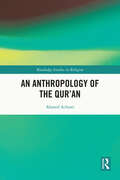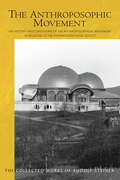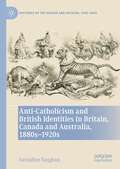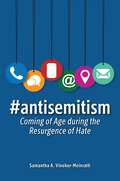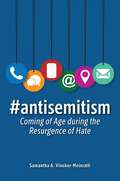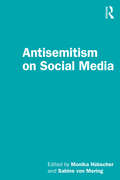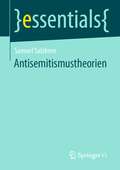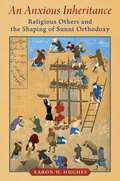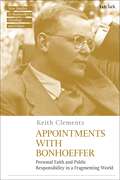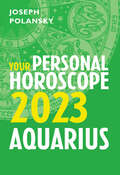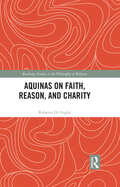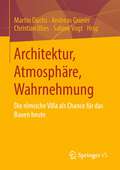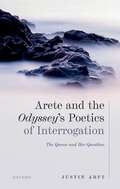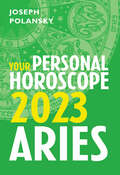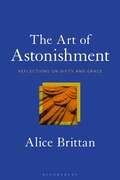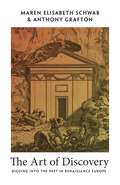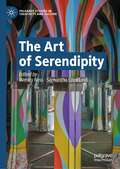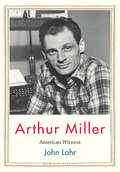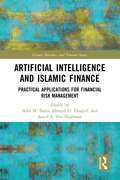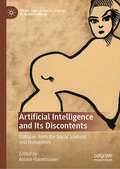- Table View
- List View
An Anthropology of the Qur’an (Routledge Studies in Religion)
by Ahmed AchratiThis book presents an anthropological study of the Qur’an, offering an unprecedented challenge to some of the epistemological and metaphysical assumptions of the tawḥīdic discourses. Combining primary textual materials and anthropological analysis, this book examines transcendence as a core principle of the Qur’an, uniquely signified in the divine name al-Quddūs (the Holy). It shows how the tawḥīdic representations of Allah constitute an inversion of this attribute; examines how this inversion has been conceived, authorized, and maintained; and demonstrates how it has affected Islamic thinking and practices, especially as relates to authority. This book also explores how a return to the Qur’anic primacy of God’s otherness as al-Quddūs can influence Islamic thinking and practices moving forward. Therefore, it will be highly useful to scholars of Islamic Studies, philosophical theology, Qur’anic studies, political science, ethics, anthropology, and religious studies.
An Anthropology of the Qur’an (Routledge Studies in Religion)
by Ahmed AchratiThis book presents an anthropological study of the Qur’an, offering an unprecedented challenge to some of the epistemological and metaphysical assumptions of the tawḥīdic discourses. Combining primary textual materials and anthropological analysis, this book examines transcendence as a core principle of the Qur’an, uniquely signified in the divine name al-Quddūs (the Holy). It shows how the tawḥīdic representations of Allah constitute an inversion of this attribute; examines how this inversion has been conceived, authorized, and maintained; and demonstrates how it has affected Islamic thinking and practices, especially as relates to authority. This book also explores how a return to the Qur’anic primacy of God’s otherness as al-Quddūs can influence Islamic thinking and practices moving forward. Therefore, it will be highly useful to scholars of Islamic Studies, philosophical theology, Qur’anic studies, political science, ethics, anthropology, and religious studies.
The Anthroposophic Movement: The History and Conditions of the Anthroposophical Movement in Relation to the Anthroposophical Society. An Encouragement for Self-Examination
by Rudolf SteinerThis course of lectures was given at a pivotal point in the development of the anthroposophic movement. Just months before, an act of arson had caused the destruction of the first Goetheanum, and its darkened ruins appeared to reflect the fragmentations within the Anthroposophical Society. Divisions were appearing amongst members and friends, with individual energies increasingly routed to external initiatives and practical projects. It became apparent that a new impetus was needed. In this turbulent context, Steiner delivers these lectures in a calm, lively and informal style. In the last decades of the nineteenth century, he says, a yearning for spiritual nourishment arose within Western culture, and organizations such as the Theosophical Society gained in popularity. Despite his direct involvement in these events, Steiner describes in dispassionate tones how the spiritual movements behind theosophy and anthroposophy were able to work together harmoniously, before an unavoidable separation took place. Steiner’s expansive review of the anthroposophic movement is an important narrative account of the developing Western spiritual tradition and the history of the Mysteries. These lectures also offer rare perceptions of the life and philosophy of Rudolf Steiner. Those who identify with the movement he founded will discover revelatory insights to its background and possibilities for its future development within the broader evolution of humankind.
Anti-Catholicism and British Identities in Britain, Canada and Australia, 1880s-1920s (Histories of the Sacred and Secular, 1700–2000)
by Geraldine VaughanRecent debates about the definition of national identities in Britain, along with discussions on the secularisation of Western societies, have brought to light the importance of a historical approach to the notion of Britishness and religion. This book explores anti-Catholicism in Britain and its Dominions, and forms part of a notable revival over the last decade in the critical historical analysis of anti-Catholicism. It employs transnational and comparative historical approaches throughout, thanks to the exploration of relevant original sources both in the United Kingdom and in Australia and Canada, several of them untapped by other scholars. It applies a 'four nations' approach to British history, thus avoiding an Anglocentric viewpoint.
#antisemitism: Coming of Age during the Resurgence of Hate
by Samantha A. Vinokor-MeinrathExploring what it means to come of age in an era marked by increasing antisemitism, readers see through the eyes of Jewish Gen Zers how identities are shaped in response to and in defiance of antisemitism.Using personal experiences, qualitative research, and the historic moment in which Generation Z is coming of age, Jewish educator Samantha Vinokor-Meinrath uses antisemitism from both the political left and the right to explore identity development among Jewish Generation Zers. With insights from educators, students, activists, and more, she holds a lens up to current antisemitism and its impact on the choices and opinions of the next generation of Jewish leaders.Chapters cover Holocaust education for the final generation able to speak directly to Holocaust survivors and learn their stories firsthand; anti-Zionism as a modern manifestation of antisemitism; and how the realities of 21st-century America have shaped the modern Jewish experience, ranging from the synagogue shooting in Pittsburgh to how Generation Zers use social media and understand diversity. The core of this book is a collection of stories: of intersectional identity, of minority affiliations, and of overcoming adversity in order to flourish and thrive.
#antisemitism: Coming of Age during the Resurgence of Hate
by Samantha A. Vinokor-MeinrathExploring what it means to come of age in an era marked by increasing antisemitism, readers see through the eyes of Jewish Gen Zers how identities are shaped in response to and in defiance of antisemitism.Using personal experiences, qualitative research, and the historic moment in which Generation Z is coming of age, Jewish educator Samantha Vinokor-Meinrath uses antisemitism from both the political left and the right to explore identity development among Jewish Generation Zers. With insights from educators, students, activists, and more, she holds a lens up to current antisemitism and its impact on the choices and opinions of the next generation of Jewish leaders.Chapters cover Holocaust education for the final generation able to speak directly to Holocaust survivors and learn their stories firsthand; anti-Zionism as a modern manifestation of antisemitism; and how the realities of 21st-century America have shaped the modern Jewish experience, ranging from the synagogue shooting in Pittsburgh to how Generation Zers use social media and understand diversity. The core of this book is a collection of stories: of intersectional identity, of minority affiliations, and of overcoming adversity in order to flourish and thrive.
Antisemitism on Social Media
by Monika Hübscher and Sabine von MeringAntisemitism on Social Media is a book for all who want to understand this phenomenon. Researchers interested in the matter will find innovative methodologies (CrowdTangle or Voyant Tools mixed with discourse analysis) and new concepts (tertiary antisemitism, antisemitic escalation) that should become standard in research on antisemitism on social media. It is also an invitation to students and up-and-coming and established scholars to study this phenomenon further. This interdisciplinary volume addresses how social media with its technology and business model has revolutionized the dissemination of antisemitism and how this impacts not only victims of antisemitic hate speech but also society at large. The book gives insight into case studies on different platforms such as Twitter, Facebook, TikTok, YouTube, and Telegram. It also demonstrates how social media is weaponized through the dissemination of antisemitic content by political actors from the right, the left, and the extreme fringe, and critically assesses existing counter-strategies. People working for social media companies, policy makers, practitioners, and journalists will benefit from the questions raised, the findings, and the recommendations. Educators who teach courses on antisemitism, hate speech, extremism, conspiracies, and Holocaust denial but also those who teach future leaders in computer technology will find this volume an important resource.
Antisemitism on Social Media
by Monika Hübscher Sabine Von MeringAntisemitism on Social Media is a book for all who want to understand this phenomenon. Researchers interested in the matter will find innovative methodologies (CrowdTangle or Voyant Tools mixed with discourse analysis) and new concepts (tertiary antisemitism, antisemitic escalation) that should become standard in research on antisemitism on social media. It is also an invitation to students and up-and-coming and established scholars to study this phenomenon further. This interdisciplinary volume addresses how social media with its technology and business model has revolutionized the dissemination of antisemitism and how this impacts not only victims of antisemitic hate speech but also society at large. The book gives insight into case studies on different platforms such as Twitter, Facebook, TikTok, YouTube, and Telegram. It also demonstrates how social media is weaponized through the dissemination of antisemitic content by political actors from the right, the left, and the extreme fringe, and critically assesses existing counter-strategies. People working for social media companies, policy makers, practitioners, and journalists will benefit from the questions raised, the findings, and the recommendations. Educators who teach courses on antisemitism, hate speech, extremism, conspiracies, and Holocaust denial but also those who teach future leaders in computer technology will find this volume an important resource.
Antisemitismustheorien (essentials)
by Samuel SalzbornDas Buch fasst die theoretischen Erkenntnisse der sozialwissenschaftlichen Antisemitismusforschung zusammen. Berücksichtigt werden dabei die Mikro-, die Meso- und die Makroebene, was psychologische, soziologische und politikwissenschaftliche/philosophische Ansätze umfasst. Dargestellt werden Fragen des Individuums und der antisemitischen Persönlichkeit, der sozialen Vermittlung in Kultur, Gesellschaft und Masse sowie der gesellschaftlichen, ökonomischen und politischen Strukturen.
An Anxious Inheritance: Religious Others and the Shaping of Sunni Orthodoxy
by Aaron W. HughesAn Anxious Inheritance reveals the tensions between the early framers of Islam and the ever-expandable category of non-Muslims. Examining the encounter with these religious others, and showing how the Qur'an functioned as both a script to understand them and a map to classify them, this study traces the key role that these religious others played in what would ultimately emerge as (Sunni) orthodoxy. This orthodoxy would appear to be the natural outgrowth of the Prophet Muhammad's preaching, but it ultimately amounted to little more than a retroactive projection of later ideas onto the earliest period. Non-Muslims (among them Christians, Jews, Zoroastrians) and the "wrong" kinds of Muslims (e.g., the Shi'a) became integral--by virtue of their perceived stubbornness, infidelity, heresy, or the like--to the understanding of what true religion was not and, just as importantly, what it should be. These non-Muslims were rarely real individuals or groups; rather, they functioned as textual foils that could be conveniently orchestrated, and ultimately controlled, to facilitate Muslim self-definition. Without such religious others proper belief could, quite literally, not be articulated. Shedding new light on the early history of Islam, while also problematizing the binary of orthodoxy/heresy in the study of religion, An Anxious Inheritance makes significant contributions to a number of diverse academic fields.
Appointments with Bonhoeffer: Personal Faith and Public Responsibility in a Fragmenting World (T&T Clark New Studies in Bonhoeffer’s Theology and Ethics)
by Keith ClementsKeith Clements sets out how and why Dietrich Bonhoeffer, more than seventy-five years after his execution by the Nazis, still speaks cogently both to the churches and society. Beginning with the earlier reception of him as a martyr-figure and then as a provocatively original theologian, this book argues his relevance to contemporary engagement with public ethics, ecumenism, truth-telling and reconciliation, the relation between faith and democracy in a time of political extremisms, the issues of national identity signalled by Brexit, and the challenge of finding an ethical response to such challenges as the global pandemic. Bonhoeffer's perception that living representatively on behalf of others is both the key to who God is as known in Jesus Christ, and the basis of all truly human community, provides the connecting thread running through these chapters on what it means to believe and be responsible in a fragmenting world. Clements also links this thread to the seventeenth-century spiritual writer Thomas Traherne and the Catholic Modernist Friedrich von Hügel.
Aquarius 2023: Your Personal Horoscope
by Joseph PolanskyYour complete one-volume guide to the year 2023. This fantastic and in-depth book includes month-by-month forecasts for every sign and all you need to know to find out what is in store for you in the year ahead. The only one-volume horoscope you’ll ever need.
Aquinas on Faith, Reason, and Charity (Routledge Studies in the Philosophy of Religion)
by Roberto Di CeglieThis book offers a new reading of Aquinas’ views on faith. The author argues that the theological nature of faith is crucial to Aquinas’ thought, and that it gives rise to a peculiar and otherwise incomprehensible relationship with reason. The first part of the book examines various modern and contemporary accounts of the relationship between faith and reason in Aquinas’ thought. The author shows that these accounts are unconvincing because they exhibit what he calls a Lockean view of faith and reason, which maintains that the relationship in question should only be treated by way of evidence. In other words, this view ignores the specific nature of the Christian faith and the equally specific way it needs to relate to reason. The second part offers a comprehensive account of Aquinas’ view of faith. It focuses on the way the divine grace and charity shape the relationship between evidence and human will. The final part of the book ties these ideas together to show how Christian faith, with its specifically theological nature, is perfectly compatible with rational debates. It also argues that employing the specificity of faith may constitute the best way to promote autonomous and successful rational investigations. Aquinas on Faith, Reason, and Charity will be of interest to scholars and advanced students working on Aquinas, philosophy of religion, Christian theology, and medieval philosophy.
Aquinas on Faith, Reason, and Charity (Routledge Studies in the Philosophy of Religion)
by Roberto Di CeglieThis book offers a new reading of Aquinas’ views on faith. The author argues that the theological nature of faith is crucial to Aquinas’ thought, and that it gives rise to a peculiar and otherwise incomprehensible relationship with reason. The first part of the book examines various modern and contemporary accounts of the relationship between faith and reason in Aquinas’ thought. The author shows that these accounts are unconvincing because they exhibit what he calls a Lockean view of faith and reason, which maintains that the relationship in question should only be treated by way of evidence. In other words, this view ignores the specific nature of the Christian faith and the equally specific way it needs to relate to reason. The second part offers a comprehensive account of Aquinas’ view of faith. It focuses on the way the divine grace and charity shape the relationship between evidence and human will. The final part of the book ties these ideas together to show how Christian faith, with its specifically theological nature, is perfectly compatible with rational debates. It also argues that employing the specificity of faith may constitute the best way to promote autonomous and successful rational investigations. Aquinas on Faith, Reason, and Charity will be of interest to scholars and advanced students working on Aquinas, philosophy of religion, Christian theology, and medieval philosophy.
Architektur, Atmosphäre, Wahrnehmung: Die römische Villa als Chance für das Bauen heute
by Martin Düchs Andreas Grüner Christian Illies Sabine Vogt„Nach Rom Architekturstudenten zu schicken heißt, sie für ihr ganzes Leben zu ruinieren.“ (Le Corbusier 1922). Im Sinne dieses Verdikts hat sich die Architekturmoderne radikal von der klassizistischen Tradition abgewandt, in der die antike Baukunst als Schulung, Folie und Muster galt, indem man ihre Formen, Strukturen und Proportionen formalästhetisch analysierte und nachahmte. Doch gab es bereits in der Antike ein anderes Konzept von Architekturverständnis: das sinnliche Erleben von Raumsequenzen und die Gestaltung von Atmosphären. Vorgeführt wird uns ein solches Verständnis in Bauten wie der Villa Hadriana aber auch in den „Villenbriefen“ des römischen Senators Plinius d. J. (um 100 n. Chr.). Von Architekten wurden Letztere lebhaft diskutiert, bis die Moderne jede Beschäftigung mit der Antike „untersagte“.Der Band „Architektur, Atmosphäre, Wahrnehmung“ versammelt nun zehn Beiträge, die wieder alle –mehr oder weniger intensiv – als Ausgangsbasis die Villenbriefe nutzen, allerdings nicht, um mit ihnen einen formalästhetischen Zugriff auf die Antike wiederzubeleben, sondern, weil der von Plinius vorgeführte und in der Forschung bis dato vernachlässigte Blick auf die römische Villa unter dem Aspekt einer sequentiellen Sinnlichkeit eine „Chance für das Bauen heute“ ist.Im Ergebnis kann man festhalten: Egal ob man Architekturstudenten nach Rom schickt oder nicht – in jedem Fall sollte man sie Plinius lesen lassen.
Arete and the Odyssey's Poetics of Interrogation: The Queen and Her Question
by Justin ArftArete and the Odyssey's Poetics of Interrogation explores how the enigmatic Phaeacian queen, Arete, is at the heart of an epic-scale "poetics of interrogation" used throughout the Odyssey to negotiate Odysseus' kleos, or epic renown. Arete's interrogation of Odysseus has been especially problematic in scholarship, but diachronic and synchronic analysis of similar interrogations across Indo-European, Orphic, and Greek epigrammatic corpora show that the "stranger's interrogation" is a formula that demands performance and negotiation of status. Within the Odyssey, this interrogation is part of an intraformular network used to generate kleos, and the queen's question initiates the longest and most complex negotiation of Odysseus' status in epic and memory. Arete's role as interrogator not only explains her strange authority and resonance with both Penelope and comparative afterlife figures, but it also establishes a gendered, agonistic tension between she and her husband, Alkinoos, that influences the structure, genre, and narratology of performances across the Phaeacian episode. This book reinterprets the Odyssey's central episode and challenges several assumptions about Nausikaa and Alkinoos' famed hospitality, even demonstrating how the Apologue is organized as a response to competing inquiries into Odysseus' fundamental status in tradition. The Odyssey ultimately navigates away from Odysseus' public reputation and roots his status in private memories, and Arete's carefully arranged interventions signal the larger process by which the Odyssey immortalizes Odysseus in poetry as a nostos hero. The queen and her question invite new applications of oral poetics that shed light on the structure, composition, and reperformance of the Odyssey.
Aries 2023: Your Personal Horoscope
by Joseph PolanskyYour complete one-volume guide to the year 2023. This fantastic and in-depth book includes month-by-month forecasts for every sign and all you need to know to find out what is in store for you in the year ahead. The only one-volume horoscope you’ll ever need.
The Art of Astonishment: Reflections on Gifts and Grace
by Alice BrittanPart literary history, part personal memoir, Alice Brittan's beautifully written The Art of Astonishment explores the rich intellectual, religious, and philosophical history of the gift and tells the interconnected story of grace: where it comes from and what it is believed to accomplish. Covering a remarkable range of materials-from The Epic of Gilgamesh, The Iliad, and the tragedies of Classical Greece, through the brothers Grimm and Montaigne, to C. S. Lewis, Toni Morrison, J. M. Coetzee, Elena Ferrante, Karl Ove Knausgaard, and Jhumpa Lahiri-Brittan moves with ease from personal story to myth, to theology, to literature and analysis, examining the nature of social and communal obligation, the role of the intellectual in times of crisis, and the pleasures of reading.In the 21st century, we might imagine grace as a striking and refined quality that is pleasurable to encounter but certainly not fundamental to anyone's existence or to the beliefs and practices that hold us together or drive us apart. For millennia, though, it has been recognized as essential to the vitality of inner life, as well as to the large-scale shifts in perspective and legislation that improve the way we live as a society. Grace is also astonishing-always-as the enormously insightful readings in The Art of Astonishment show. Brittan reveals the concept's breadth as sacred and secular, ancient and recent, lived and literary. And in so doing, she shows us how the act of reading is like grace-social but personal, pleasurable and essential.
The Art of Discovery: Digging into the Past in Renaissance Europe
by Maren Elisabeth Schwab Anthony GraftonA panoramic history of the antiquarians whose discoveries transformed Renaissance culture and gave rise to new forms of art and knowledgeIn the early fifteenth century, a casket containing the remains of the Roman historian Livy was unearthed at a Benedictine abbey in Padua. The find was greeted with the same enthusiasm as the bones of a Christian saint, and established a pattern that antiquarians would follow for centuries to come. The Art of Discovery tells the stories of the Renaissance antiquarians who turned material remains of the ancient world into sources for scholars and artists, inspirations for palaces and churches, and objects of pilgrimage and devotion.Maren Elisabeth Schwab and Anthony Grafton bring to life some of the most spectacular finds of the age, such as Nero’s Golden House and the wooden placard that was supposedly nailed to the True Cross. They take readers into basements, caves, and cisterns, explaining how digs were undertaken and shedding light on the methods antiquarians—and the alchemists and craftspeople they consulted—used to interpret them. What emerges is not an origin story for modern archaeology or art history but rather an account of how early modern artisanal skills and technical expertise were used to create new knowledge about the past and inspire new forms of art, scholarship, and devotion in the present.The Art of Discovery challenges the notion that Renaissance antiquarianism was strictly a secular enterprise, revealing how the rediscovery of Christian relics and the bones of martyrs helped give rise to highly interdisciplinary ways of examining and authenticating objects of all kinds.
The Art of Discovery: Digging into the Past in Renaissance Europe
by Maren Elisabeth Schwab Anthony GraftonA panoramic history of the antiquarians whose discoveries transformed Renaissance culture and gave rise to new forms of art and knowledgeIn the early fifteenth century, a casket containing the remains of the Roman historian Livy was unearthed at a Benedictine abbey in Padua. The find was greeted with the same enthusiasm as the bones of a Christian saint, and established a pattern that antiquarians would follow for centuries to come. The Art of Discovery tells the stories of the Renaissance antiquarians who turned material remains of the ancient world into sources for scholars and artists, inspirations for palaces and churches, and objects of pilgrimage and devotion.Maren Elisabeth Schwab and Anthony Grafton bring to life some of the most spectacular finds of the age, such as Nero’s Golden House and the wooden placard that was supposedly nailed to the True Cross. They take readers into basements, caves, and cisterns, explaining how digs were undertaken and shedding light on the methods antiquarians—and the alchemists and craftspeople they consulted—used to interpret them. What emerges is not an origin story for modern archaeology or art history but rather an account of how early modern artisanal skills and technical expertise were used to create new knowledge about the past and inspire new forms of art, scholarship, and devotion in the present.The Art of Discovery challenges the notion that Renaissance antiquarianism was strictly a secular enterprise, revealing how the rediscovery of Christian relics and the bones of martyrs helped give rise to highly interdisciplinary ways of examining and authenticating objects of all kinds.
The Art of Serendipity (Palgrave Studies in Creativity and Culture)
by Samantha Copeland Wendy RossSerendipity and creativity are both broad, widely disputed, and yet consistently popular concepts which are relevant to understanding the positive aspects of our daily lives and even human progress in the arts and sciences. The chapters in this book reflects a variety of theoretical and practical approaches to serendipity in various domains, including creative problem solving, sculpture, writing, theatre and design. Chapter authors address issues such as the nature of the ‘prepared mind’, the role of accidents, serendipity as a skill or way of engaging with the world and, indeed, how serendipity works as a concept and practice in relation to the dynamic flow of the creative system. Those who wish to explore the nature of chance in art and creativity, as well as in their daily lives, will find much to ponder in these pages.
Arthur Miller: American Witness (Jewish Lives)
by John LahrA great theater critic brings twentieth-century playwright Arthur Miller’s dramatic story to life with bold and revealing new insights “New Yorker critic Lahr shines in this searching account of the life of playwright Arthur Miller. . . . It’s a great introduction to a giant of American letters.”—Publishers Weekly Distinguished theater critic John Lahr brings unique perspective to the life of Arthur Miller (1915–2005), the playwright who almost single-handedly propelled twentieth-century American theater into a new level of cultural sophistication. Organized around the fault lines of Miller’s life—his family, the Great Depression, the rise of fascism, Elia Kazan and the House Committee on Un-American Activities, Marilyn Monroe, Vietnam, and the rise and fall of Miller’s role as a public intellectual—this book demonstrates the synergy between Arthur Miller’s psychology and his plays. Concentrating largely on Miller’s most prolific decades of the 1940s, 1950s, and 1960s, Lahr probes Miller’s early playwriting failures; his work writing radio plays during World War II after being rejected for military service; his only novel, Focus; and his succession of award-winning and canonical plays that include All My Sons, Death of a Salesman, and The Crucible, providing an original interpretation of Miller’s work and his personality.
Artificial Intelligence and Islamic Finance: Practical Applications for Financial Risk Management (Islamic Business and Finance Series)
by Adel M. Sarea Ahmed H. Elsayed Saeed A. Bin-NashwanThis book provides a systematic overview of the current trends in research relating to the use of artificial intelligence in Islamic financial institutions (IFIs), across all organization of Islamic cooperation (OIC) countries. Artificial Intelligence and Islamic Finance discusses current and potential applications of artificial intelligence (AI) for risk management in Islamic finance. It covers various techniques of risk management, encompassing asset and liability management risk, credit, market, operational, liquidity risk, as well as regulatory and Shariah risk compliance within the financial industry. The authors highlight AI’s ability to combat financial crime such as monitoring trader recklessness, anti-fraud and anti-money laundering, and assert that the capacity of machine learning (ML) to examine large amounts of data allows for greater granular and profound analyses across a variety of Islamic financial products and services. The book concludes with practical limitations around data management policies, transparency, and lack of necessary skill sets within financial institutions. By adopting new methodological approaches steeped in an Islamic economic framework (e.g., analysing FinTech in the context of Shariah principles and Islamic values), it devises practical solutions and generates insightful knowledge, helping readers to understand and explore the role of technological enablers in the Islamic finance industry, such as RegTech and artificial intelligence, in providing better and Shariah-compliant services to customers through digital platforms. The book will attract a wide readership spanning Shariah scholars, academicians, and researchers as well as Islamic financial practitioners and policymakers.
Artificial Intelligence and Islamic Finance: Practical Applications for Financial Risk Management (Islamic Business and Finance Series)
by Adel M. SareaThis book provides a systematic overview of the current trends in research relating to the use of artificial intelligence in Islamic financial institutions (IFIs), across all organization of Islamic cooperation (OIC) countries. Artificial Intelligence and Islamic Finance discusses current and potential applications of artificial intelligence (AI) for risk management in Islamic finance. It covers various techniques of risk management, encompassing asset and liability management risk, credit, market, operational, liquidity risk, as well as regulatory and Shariah risk compliance within the financial industry. The authors highlight AI’s ability to combat financial crime such as monitoring trader recklessness, anti-fraud and anti-money laundering, and assert that the capacity of machine learning (ML) to examine large amounts of data allows for greater granular and profound analyses across a variety of Islamic financial products and services. The book concludes with practical limitations around data management policies, transparency, and lack of necessary skill sets within financial institutions. By adopting new methodological approaches steeped in an Islamic economic framework (e.g., analysing FinTech in the context of Shariah principles and Islamic values), it devises practical solutions and generates insightful knowledge, helping readers to understand and explore the role of technological enablers in the Islamic finance industry, such as RegTech and artificial intelligence, in providing better and Shariah-compliant services to customers through digital platforms. The book will attract a wide readership spanning Shariah scholars, academicians, and researchers as well as Islamic financial practitioners and policymakers.
Artificial Intelligence and Its Discontents: Critiques from the Social Sciences and Humanities (Social and Cultural Studies of Robots and AI)
by Ariane HanemaayerOn what basis can we challenge Artificial Intelligence (AI) - its infusion, investment, and implementation across the globe? This book answers this question by drawing on a range of critical approaches from the social sciences and humanities, including posthumanism, ethics and human values, surveillance studies, Black feminism, and other strategies for social and political resistance. The authors analyse timely topics, including bias and language processing, responsibility and machine learning, COVID-19 and AI in health technologies, bio-AI and nanotechnology, digital ethics, AI and the gig economy, representations of AI in literature and culture, and many more. This book is for those who are currently working in the field of AI critique and disruption as well as in AI development and programming. It is also for those who want to learn more about how to doubt, question, challenge, reject, reform and otherwise reprise AI as it been practiced and promoted.
